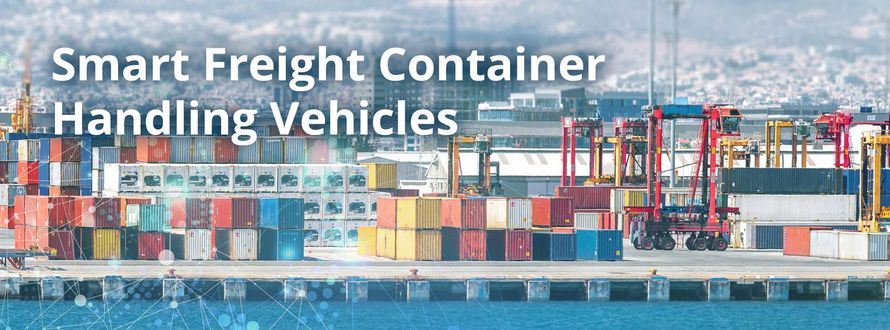
Revolutionizing Logistics: The Rise of Smart Freight Container Handling Vehicles
– PikeOS, Automotive, Industrial Automation, SafetyFreight container handling vehicles are being used more and more in the logistics and transportation industry, where the efficient movement and management of goods play a vital role in supporting global commerce. As the demand for fast, efficient, and scalable solutions grows, freight container handling vehicles have evolved into sophisticated helpers capable of operating in complex, high-pressure environments such as ports, warehouses, and distribution centers. These vehicles, which include reach stackers, container cranes, straddle carriers, and Automated Guided Vehicles (AGVs), are specifically designed to manage the heavy loads and precise requirements involved in container transport.
The primary function of these vehicles is to enable the swift and safe movement of containers within facilities or to transport them between modes of transportation, like from ships to trains or trucks. Given the sheer volume of global container traffic, managing this flow effectively is a huge task. Let's delve into the challenges associated with freight container handling vehicles, the solutions developed to address these issues, and recent technological advancements that are enhancing vehicle performance, safety, and efficiency.
Challenges in Freight Container Handling
Handling freight containers presents numerous technical, operational, and environmental challenges. The industry must contend with high demands for speed, accuracy, and safety, all of which can be difficult to achieve in busy and often hazardous environments.
Key challenges include:
- High Load Demands and Structural Integrity: Freight containers are heavy and require robust vehicles with high structural integrity to lift, move, and stack them safely. These vehicles need to withstand the stresses of frequent, heavy lifting while also meeting stringent safety standards to protect operators and minimize equipment wear.
- Safety and Operator Welfare: The large nature of freight containers increases the risk of accidents, including collisions and tipping. The physical safety of operators and on-ground personnel is of utmost concern, especially in high-traffic areas like container terminals. Additionally, operators face health risks from prolonged shifts in physically demanding roles, such as exposure to noise and vehicle vibrations.
- Space Constraints and Efficient Navigation: Port and warehouse space is often limited, requiring container handling vehicles to navigate narrow aisles and stack containers as efficiently as possible. In large facilities, improper space management can lead to congestion, increased handling time, and decreased overall productivity.
- Environmental Impact and Energy Efficiency: The heavy fuel consumption of these large machines contributes to their environmental footprint. Operators face the dual challenge of adhering to increasingly strict emissions regulations while keeping operating costs manageable. Consequently, the industry is under pressure to adopt cleaner technologies and minimize energy consumption without sacrificing productivity.
- Complexity in Automation and Digital Integration: Automation offers clear productivity benefits, but integrating digital solutions with existing mechanical and operational frameworks is challenging. Autonomous container handling, guided by artificial intelligence (AI) and Internet of Things (IoT) connectivity, introduces new demands on both vehicle hardware and software infrastructure. Real-time decision-making, required for obstacle avoidance and route planning, places high demands on computing systems, making integration and scalability a key hurdle.
Solutions to Freight Container Handling Challenges
To address these challenges, the industry has developed a range of solutions, including mechanical enhancements, advanced software systems, and automation technologies.
Here are some of the primary approaches:
- Enhanced Vehicle Design and Materials: Modern container handling vehicles are made with stronger and lighter materials to improve durability without compromising mobility. Improved ergonomics in vehicle cabins enhance operator comfort, and shock-absorbing technologies reduce the strain from heavy lifting operations. Advanced hydraulic and pneumatic systems also allow vehicles to manage heavier loads with precision, reducing the risk of damage to containers and vehicles.
- Safety Systems and Automation: To improve safety, many container handling vehicles are equipped with automated safety systems, including collision avoidance, load sensing, and anti-tip mechanisms. Cameras and sensors provide operators with 360-degree views, helping them navigate tight spaces. In addition, remote control and semi-autonomous operation reduce the need for direct human involvement in dangerous areas, significantly reducing accident risks.
- Efficient Space and Route Management: Space and route management solutions include warehouse and yard management systems that optimize container placement and retrieval. By tracking container locations and monitoring real-time vehicle movements, these systems prevent bottlenecks and improve operational flow. The integration of these systems with fleet management software provides insights into vehicle performance, maintenance needs, and optimal routing, allowing companies to make data-driven decisions.
- Alternative Fuels and Electrification: To mitigate environmental impacts, many companies are transitioning to electric container handling vehicles. Electric-powered alternatives reduce fuel dependency and emissions, providing a cleaner alternative for port and warehouse operations. Hydrogen fuel cells and hybrid models are also emerging as sustainable options for high-power applications, offering the power required for heavy lifting without the associated carbon footprint.
- Real-Time Software Solutions for Automation and Safety: Real-time operating systems (RTOS) are instrumental in supporting automation, real-time decision-making, and system integration in freight container handling. SYSGO, a provider of RTOS solutions, has been at the forefront of developing reliable and secure platforms that enable seamless operation in mission-critical applications. For example, SYSGO’s PikeOS RTOS provides the real-time response needed for automated container handling, where delays or errors can have significant safety and productivity implications.
Real-Time Solutions from SYSGO
SYSGO’s real-time solutions play a crucial role in advancing the capabilities of freight container handling vehicles. Our PikeOS RTOS, a hypervisor-based operating system, is designed for safety-critical applications, ensuring that container handling vehicles operate reliably and securely.
PikeOS provides several distinct benefits for container handling, including:
- Real-Time Data Processing: PikeOS enables real-time data processing, which is essential for high-stakes environments like container terminals where split-second decisions impact safety and efficiency. For example, if an obstacle suddenly appears in a vehicle’s path, the system can trigger an immediate response, such as braking or rerouting.
- Enhanced Safety through Partitioning: PikeOS uses a partitioned architecture that segregates critical functions (like braking and navigation) from non-critical ones (like operator interfaces). This separation helps prevent system failures by isolating faults, ensuring that essential functions continue uninterrupted. In the event of a malfunction in one system, others can remain operational, minimizing disruption.
- Integration of Multiple Systems: SYSGO’s solutions facilitate the integration of diverse subsystems—such as sensors, cameras, GPS, and automated controls—onto a single platform, simplifying the architecture and reducing hardware requirements. This interoperability streamlines the control and coordination of vehicle functions, enhancing overall efficiency.
- Certification and Compliance for Safety-Critical Applications: PikeOS supports safety certifications in accordance with ISO 26262, a key standard for functional safety in road vehicles. While traditionally used in the automotive sector, ISO 26262 is increasingly applicable to autonomous and semi-autonomous container handling vehicles, where advanced driver assistance, obstacle detection, and real-time system control demand proven safety standards. SYSGO's experience with safety certifications allows OEMs and integrators in logistics and port automation to develop systems that are not only high-performing but also certifiably safe—accelerating time-to-market and meeting regulatory requirements with confidence.
- Cybersecurity: Security can be crucial for vehicles operating in networked environments where cyber threats pose significant risks. PikeOS is equipped with built-in security features that protect against unauthorized access, ensuring that critical vehicle functions are safeguarded against potential cyber attacks. This capability is particularly important for automated systems where connectivity and data integrity are essential.
- Support for Autonomous Operations: PikeOS’s real-time capabilities support autonomous container handling by enabling instantaneous processing of sensor data, facilitating precise and autonomous vehicle movements. This level of automation is especially valuable in ports and terminals seeking to increase throughput without expanding physical space, as autonomous vehicles can operate continuously with minimal human intervention.
Conclusion and Outlook
Freight container handling vehicles are more and more becoming an indispensable asset in the global logistics infrastructure, enabling the efficient movement of goods through ports and warehouses. However, the challenges associated with heavy loads, operator safety, space limitations, environmental concerns, and digital integration demand continuous innovation. Modern solutions, such as enhanced vehicle design, alternative fuel options, and real-time software systems, are paving the way for more efficient, safer, and environmentally friendly container handling operations.
Real-time operating systems like SYSGO’s PikeOS demonstrate how software can enhance container handling by enabling real-time data processing, ensuring operational safety, integrating diverse systems, and supporting autonomous functionalities. Such advancements reduce human intervention, improve accuracy, and enable 24/7 operations, critical for meeting the increasing demand for goods movement worldwide.
Looking forward, the adoption of electric and autonomous container handling vehicles, coupled with advancements in AI and machine learning, will further revolutionize the industry. Autonomous systems, guided by RTOS platforms, are expected to become increasingly standard, enabling ports and logistics hubs to process containers faster and more efficiently. As technologies continue to advance, the freight container handling industry is well-positioned to meet the evolving demands of global trade while enhancing safety and minimizing environmental impact.
-
Previous
-
Next

 Twitter
Twitter LinkedIn
LinkedIn Facebook
Facebook Reddit
Reddit RSS
RSS Copy link
Copy link
